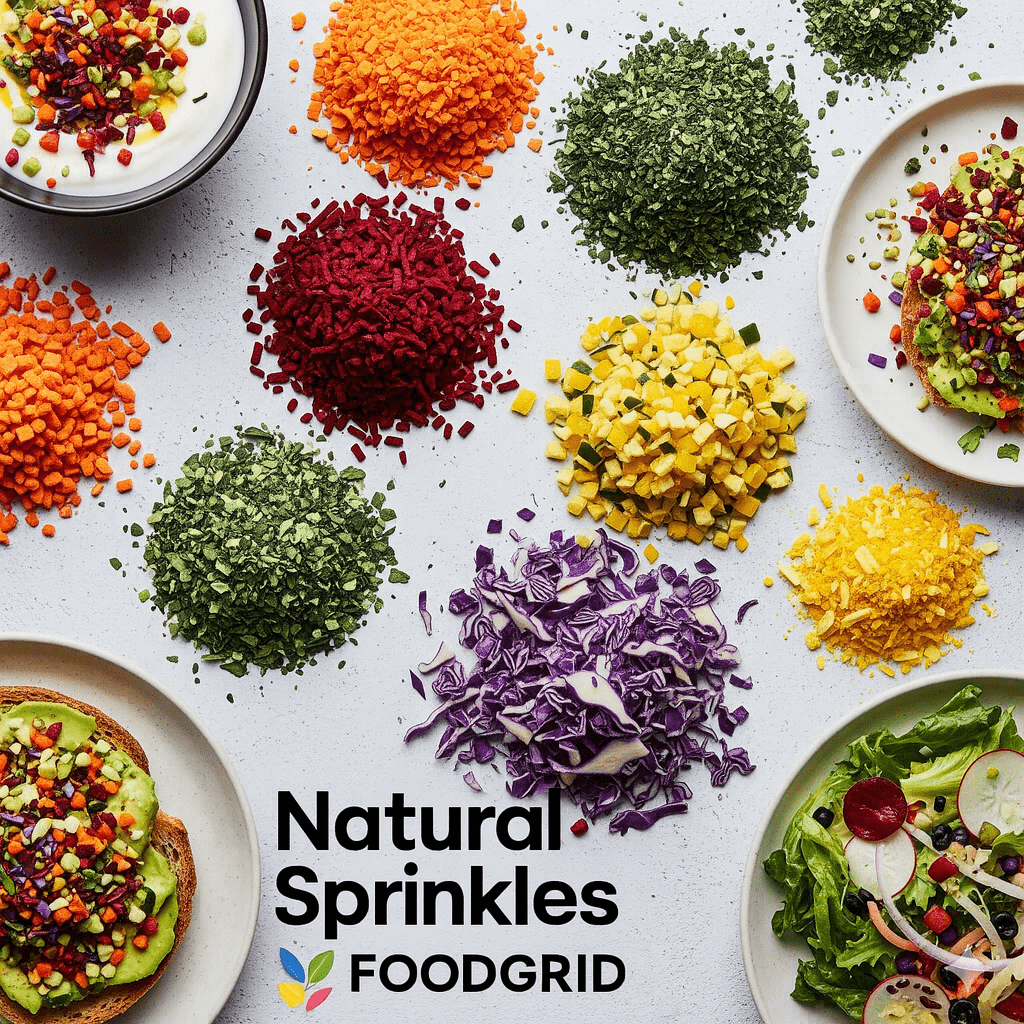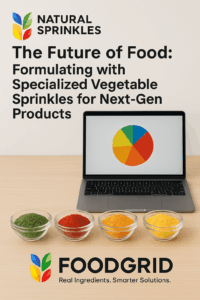Tomorrow’s most successful food products won’t just be tasty—they’ll deliver functional benefits, align with sustainability goals, and meet evolving consumer expectations. Specialized vegetable blends are at the center of this shift, offering product developers a versatile, nutrient-rich foundation for innovation.
Why Vegetable Blends are the Next Frontier in Food Innovation
The consumer food market is evolving faster than ever. According to Innova Market Insights, “plant-based” remains one of the top growth drivers in global new product launches. While single-vegetable ingredients have been popular for decades, specialized vegetable blends now offer a new level of versatility, enabling product developers to:
- Enhance nutritional profiles without artificial fortification.
- Improve sensory qualities like flavor, color, and texture.
- Support clean label and sustainability claims.
- Serve as functional ingredients in everything from snacks to beverages.
The Shift from Single Ingredients to Complex Blends
Historically, vegetable-based ingredients were used in isolation—spinach powder for green smoothies, beet juice for coloring, carrot purée for baked goods. But blends are more than the sum of their parts:
- Nutritional Synergy – Combining vegetables with complementary nutrient profiles increases the total functional value.
- Sensory Balance – Strong flavors can be moderated by milder vegetables, making formulations more appealing.
- Functional Stability – Blends can improve texture, water activity, and shelf life in processed foods.
This shift mirrors how consumers think about their diets—seeking variety, balance, and holistic benefits rather than single “superfoods.”
Formulation Benefits for Product Developers
1. Enhanced Nutritional Value
Blends allow you to deliver complete nutrient coverage—fiber, vitamins, minerals, and phytonutrients—without synthetic additives. For example:
- Spinach + Sweet Potato = Iron + Beta-Carotene + Vitamin C synergy.
- Kale + Carrot + Beet = Antioxidants + Fiber + Nitrates for cardiovascular health.
Harvard T.H. Chan School of Public Health notes that diets rich in varied vegetables are linked to reduced chronic disease risk, making blended formulations a compelling selling point.
2. Clean Label Positioning
Specialized vegetable blends help meet consumer demand for recognizable ingredients. Instead of “ascorbic acid” for vitamin C, your label can read “red bell pepper” or “broccoli concentrate.”
3. Functional Properties
Vegetable blends can contribute:
- Natural coloring (beet for red hues, spinach for green)
- Texture modification (purees for creaminess, powders for crispness)
- Moisture control (reducing added gums or starches)
4. Flexibility Across Product Categories
Specialized vegetable blends can be integrated into:
- Snacks – vegetable-based chips, crackers, and extruded products.
- Beverages – smoothies, plant-based protein drinks.
- Bakery – muffins, bread, tortillas with added vegetable nutrition.
- Prepared meals – soups, sauces, frozen entrées.
Technical Considerations in Formulating with Vegetable Blends
1. Particle Size and Texture
Fine powders work well for dry mixes, while coarse cuts or purées are better for ready-to-eat or frozen products. Particle size can influence mouthfeel and visual appeal.
2. Moisture Content
Blends with high moisture need careful water activity control to prevent microbial growth. Freeze-dried or dehydrated options can solve shelf life issues.
3. Flavor Balancing
Strong-flavored vegetables (like kale or broccoli) may require balancing with sweeter or milder vegetables (like pumpkin or zucchini) to appeal to broader consumer palates.
4. Stability and Shelf Life
Natural pigments and nutrients can degrade over time. Using blends with stabilized processing methods—like vacuum drying or cold-pressing—can preserve quality.
5. Supply Chain and Consistency
Sourcing a stable, year-round supply of consistent blends is critical. Partnering with suppliers who maintain tight quality controls and transparent sourcing will prevent formulation headaches.
USDA Agricultural Marketing Service emphasizes that consistent quality and sourcing transparency improve brand reliability and consumer trust.
Market Drivers for Specialized Vegetable Blends
1. Plant-Based Product Boom
According to The Good Food Institute, U.S. plant-based food sales grew 6.6% in 2022, outpacing total food sales. Vegetable blends allow brands to differentiate in an increasingly crowded market.
2. Functional Foods on the Rise
Consumers want foods that do more than satisfy hunger. Vegetable blends can support claims like “supports immune health” or “high in antioxidants”—provided they meet regulatory requirements.
3. Sustainability Demands
Using blends made from surplus or “imperfect” vegetables supports food waste reduction initiatives, a growing consumer priority.
4. Global Flavor Exploration
Blends incorporating regional vegetables open the door to new flavor experiences—think purple sweet potato + taro for Asian-inspired products, or tomato + poblano for Latin American profiles.
Steps for Product Developers to Leverage Vegetable Blends
Step 1: Define Your Product Goals
Are you aiming for nutritional enhancement, functional benefits, or culinary innovation? Your objective will guide the type of blend you choose.
Step 2: Partner with Specialized Suppliers
Seek partners with:
- Proven R&D collaboration experience
- Consistent supply and quality control
- Flexible blend customization
You can explore FoodGrid’s ingredient sourcing solutions for connecting with vetted, reliable suppliers of high-quality vegetable blends.
Step 3: Conduct Small-Batch Trials
Test different ratios, processing methods, and cooking parameters to optimize taste, texture, and stability.
Step 4: Validate Nutritional and Functional Claims
Collaborate with food scientists and regulatory teams to ensure your marketing claims are scientifically substantiated and legally compliant.
Step 5: Scale and Launch
Once validated, secure contracts with suppliers who can scale production without sacrificing quality or traceability.
Case Example: From Concept to Market
A plant-based soup brand wanted to enhance its immune health positioning. The R&D team formulated a vegetable blend of carrots, red bell peppers, spinach, and broccoli—delivering high levels of vitamins A, C, and K.
The blend also provided a naturally vibrant color, allowing the brand to remove artificial colorants. Launch results showed a 15% increase in repeat purchases due to perceived health benefits and cleaner labels.
Best Practices for Long-Term Success
- Continuous Innovation – Refresh blends periodically to align with seasonal availability and emerging health trends.
- Consumer Testing – Incorporate sensory panels to gauge acceptance across target demographics.
- Regulatory Awareness – Stay ahead of changing labeling and health claim requirements.
- Data-Driven Development – Track consumer purchase data to adjust formulations in real time.
References
- Innova Market Insights – Top 10 Trends in Food & Beverage (link)
- Harvard T.H. Chan School of Public Health – Vegetables and Fruits (link)
- USDA Agricultural Marketing Service – Fruit and Vegetable Programs (link)
- The Good Food Institute – State of the Plant-Based Industry (link)
Internal Links for Further Reading
- Ingredient sourcing and supplier solutions from FoodGrid
- FoodGrid blog: Latest trends in sustainable food sourcing
Conclusion: Blends are the Building Blocks of Next-Gen Foods
Specialized vegetable blends are more than a formulation trend—they’re a strategic tool for innovation in a competitive marketplace. By delivering superior nutrition, clean label appeal, and sensory balance, they empower product developers to meet consumer demand for flavorful, functional, and sustainable foods.
Looking to formulate your next product with specialized vegetable blends? Partner with FoodGrid to access premium blends, technical support, and supplier connections that help you bring next-gen food concepts to market—faster, smarter, and with unmatched quality.


